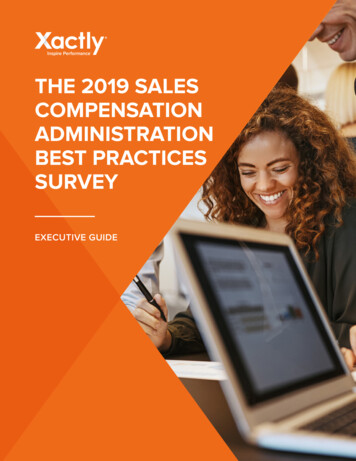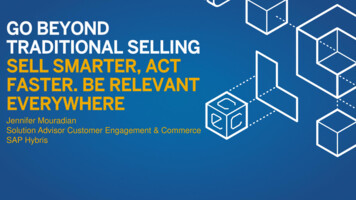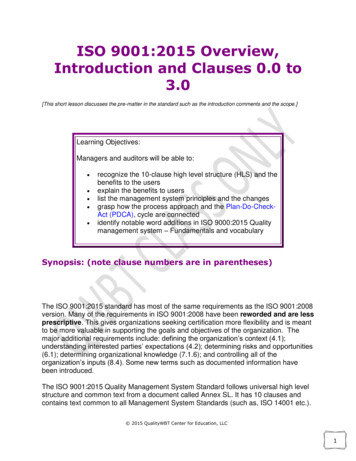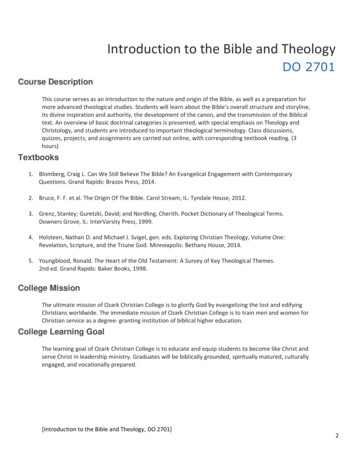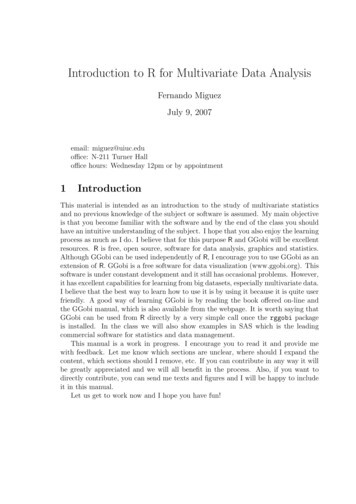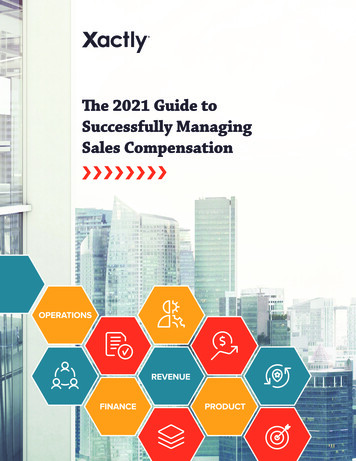
Transcription
TABLE OFCONTENTSIntroductionPreparing for Sales Compensation PlanningData: The Most Essential Compensation Planning ToolBuilding Strategic Sales Compensation PlansCompensation Plan Rollout and CommunicationAmplifying Performance with Intelligent SalesCompensation TechnologyMaking Data-driven Sales CompensationManagement a Reality1112345IntroductionRevenue organizations are no strangers to incentive compensation, and every company leverages it onsome level to motivate sales reps and drive performance. But in order to be successful, enterprises mustcontinuously optimize their incentive strategies and make swift changes to stay on target for revenue andgrowth goals.Today’s quickly-shifting selling environments are making it increasingly difficult to design, implement, andmanage sales compensation with agility—especially for companies using manual sales compensationmanagement methods.The stakes to succeed are high.In the U.S. alone, companies spend more than 800billion to manage their sales forces, with 200 billiondevoted solely to compensation each year, accordingto Harvard Business School.265%of companies have the same or higher quotassince the start of the pandemic, and 38 percenthave higher overall revenue targets.1Source: Xactly 2021 State of Global Sales Performance SurveySo it’s no surprise that more than two-thirds (77percent) of companies say they’ve accelerated theirdigital transformation over the past two years.3 In order to meet rapidly increasing revenue goals, you needreps to sell at maximum performance. That requires a top-notch incentive program.But before you can even begin to think about automating and adopting incentive technology, you have tonail down the fundamentals of compensation management, starting with your planning processes and dataquality.In this guide, we’ll cover everything you need to know about designing incentive plans, using digitaltechnology to streamline compensation management, and using the ROI of your sales incentives.PREPARING FOR SALES COMPENSATION PLANNINGIncentives play a critical role in sales behaviors and overall rep performance. Traditionally, planning hasoccurred once per year with a “set it and forget it” mindset. But today’s most successful enterprises haverealized that this approach is outdated and hinders their ability to make agile, informed decisions.2
Rather than annual planning, leading organizations are holding their usual planning periods, but they are alsocontinuously analyzing compensation plans throughout the year and making real-time adjustments based oninternal performance and external market and industry factors.Prior to planning, there are two foundational elements you need to ensure you are well-prepared forcompensation plan design and implementation. First, you need to involve the right people early on to gatherthe right information, and you also must align departmental priorities with overarching goals.BUILDING A TEAM OF KEY STAKEHOLDERSThe impact of your company’s compensation plan reaches far beyond the sales team. Each departmenthas different priorities it is focused on, but you should all be working towards the same overarching goals.Including key stakeholders helps maintain cross-departmental alignment throughout the sales compensationplanning process.Building Your Compensation Planning TeamSales LeadershipSales has the most insight into your sales force. They’ll bring historicalperformance, capacity, quota, and territory information to the table.FinanceFinance can provide key insights into projected revenue and expenses tohelp balance incentive costs and maximize the ROI of your incentives.OperationsYour Sales and Revenue Operations teams provide key knowledgearound revenue, sales cycles, pipeline, and enablement to ensureincentives are revenue-driven.CompensationCompensation admins will help determine the feasibility of yourcompensation strategy and ensure it is clear, simple, and effective.MarketingMarketing is playing an increasingly larger role in developing early-stagesales pipeline for organizations. Bringing them in will help align them sothey focus on generating leads that will support sales’ goals.ProductIncluding the product team in compensation planning will ensureincentives are aligned with goals related to product development.Sales RepsSales reps and managers will help build plan buy-in, ensure incentives areeasy to understand, and provide clear direction.GET THE ENTIRE ORGANIZATION IN ALIGNMENTBringing together the right planning team is only part of the compensation formula. Alignment is equally, ifnot more, important. You need to lay down all of the different departmental initiatives and make sure youare aligned on priorities and how they feed into overarching goals. Because, when everyone is on the samepage, you ultimately perform better, right? Exactly.3
10%Source: MinsiloMisaligned companieswaste roughly 10 percentof business spending.4Alignment on goals and trusted data is a surefireway to reduce resource waste and improveperformance, not only for compensationmanagement but the entire company as well.ENTERPRISES WITH ALIGNED DEPARTMENTS40%Achieve 40%higher win rates52.3xAre 2.3 times morelikely to regularlyexceed revenue goals450%Grow revenue50% faster472%Are 72% moreprofitable4Sources: Minsilo; ZoomInfoWith consolidated data, you center your entire organization around the same information and insights,allowing you to focus incentives on driving sales behaviors that empower you to hit targets strategically andefficiently.Data: The Most Essential Compensation Planning ToolData is the single most important factor to design and manage sales compensation effectively, and it iscritical for planning and optimizing incentives. The strongest plans are data-driven, which means you need togather as much data as possible.COMPENSATION HISTORYStart by looking at your past sales compensation plans. You’ll need to examine the incentive structures usedin the past and identify which were most and least effective at achieving goals.ASK YOURSELF: What is our typical incentive payout versus revenue earned?PAST SALES PERFORMANCEUnderstanding historical sales performance will impact how aggressively you set quotas for reps anddetermine the most effective incentives for different roles.ASK YOURSELF: How many reps, on average, hit, exceed, or miss quota?CUSTOMER INSIGHTS VS. GROWTH GOALSExamine your average amount per closed sales opportunity and the costs to acquire it. This will inform yourhiring plans, territory design, and how to structure your sales team incentives. Based on that information, youcan determine if you should target the same deals or expand the companies you’re currently pursuing.4
ASK YOURSELF: What does our average deal look like? If we continue closing onlythese deals, is it the best way to achieve our goals?CAPACITY AND RAMP TIMESThe tenure of your sales team and the number of reps on the sales floor will help you set effective quotas.Knowing how many fully-ramped salespeople you have on your team and the amount of time it takes to get anew hire to full productivity will be vital to determine the right incentives for different roles.ASK YOURSELF: How long does it take for a new rep to fully ramp, and how can wereasonably expect them to perform during their training period?EXTERNAL INDUSTRY AND MARKET DATAYour internal data provides a clear picture of your company. Adding third-party data shows how others inyour industry are paying their sales teams. This will help you develop competitive compensation plans, whichare crucial to attract and retain top talent.ASK YOURSELF: How do our incentives compare to our industry and competition?Building Strategic Sales Compensation PlansFrom the start of planning, it’s important to consider the different roles on your sales team and alignincentives to the unique tasks and processes each is responsible for. Consider a sales development rep(SDR) and a sales specialist, or sales engineer. Each role plays a vital part in the sales cycle, but the actionsthey have control over are different.You wouldn’t measure an SDR on giving demos, nor would you base a sales engineer’s performance onthe number of prospecting calls they make. Likewise, sales managers spend more time on administrativeand coaching tasks, unlike an account executive with a larger focus on selling. Throughout your salescompensation planning, it’s important to keep in mind that no two roles on your team have the sameresponsibilities, and their incentives should reflect that.DETERMINING AND SETTING PAY MIXSales compensation generally consists of a ratio of base and variable incentives, known as pay mix. This willvary for different roles, but it typically involves a guaranteed base salary with additional potential earningsthrough commissions.THERE ARE SEVERAL FACTORS THAT GO INTO SETTING THE RIGHT PAY MIX, INCLUDING THE:Type of sales roleAverage transaction volumeAverage length of the sales cycleTarget account and customer typesThe Value of BenchmarkingRemember that external third-party data we talked about compiling earlier in the guide? This is where itcomes in extremely handy. Benchmarking, or comparing your incentive structures against industry data, isthe most effective way to determine the best pay mix for your sales team.5
Insights into how other organizations are designing their compensation give you a baseline to ensure yourpay is competitive, which is critical to attract and retain top performers. In fact, HubSpot reports that one ofthe top reasons sales reps leave a role is for a higher-paying opportunity, and 43 percent of workers wouldaccept a new job for a 10 percent increase in pay.7Using a sales benchmarking tool can make this process much easier and provide a larger dataset tobenchmark against your own data.PAY MIX FOR DIFFERENT ROLESAt the most basic level, you may consider the following pay mix examples for different roles, based ontheir influence in the sales cycle and selling responsibilities. Below are a few very simple examples todemonstrate how pay mix works.The Basics: How Pay Mix WorksPAY MIX (BASE/VARIABLE)HOW DOES IT WORK?GOOD OR BAD?0/100All variable income, nobase pay.Highly effective, but can createhigh-stress environments,and weekly payouts may berequired50/50An even split of 50 percentbase incentives and 50percent variable commissionsA good starting point andoffers a level of incomesecurity80/2080 percent guaranteedcompensation and 20 percentvariable incentives.This structure works well forroles with little to no influenceon the sales cycleGenerally speaking, every sales role will have some ratio of variable pay in their compensation plan. Jobswith the most influence on sales purchasing decisions should have a more aggressive pay mix with a higherproportion of variable pay.After examining Xactly customer and industry data, we’ve determined good starting points for setting paymix for common roles on your team.6
Pay Mix Structures by RoleROLERESPONSIBILITIESIDEAL PAY MIX(BASE/VARIABLE)Account ExecutiveMost influence on sales cycles,nurturing prospects, closing deals50/50 or 60/40Sales Development Rep(SDR)Prospecting, bringing in newaccounts, and qualifying leads70/30Sales Specialist (SalesEngineer)Building and presenting in-depth,personalized demos65/35Customer Success RepManaging customer accounts, crossselling and upselling65/35Sales ManagerManaging entire sales team,coaching, reporting75/25 or 80/20PLAN ELIGIBILITYPlan eligibility answers a fundamental question: Who should be on a variable compensation plan?A good rule of thumb to decide if someone should be eligible is if their role:Has significant contact with prospects or customersInfluences customers to purchase at any point in the customer lifecycleHas a high level of involvement or ownership in the sales processIs defined by clear and quantifiable sales objectivesNearly every person on your sales team will be eligible for your sales compensation plan and work towardsearning some sort of variable pay. For those that play a role in sales, but don’t necessarily play a direct rolein the sales cycle (e.g., marketing, product development, engineering, etc.), you may consider an alternativeincentive structure.We’ll touch more on incentives for non-sales employees later on in this guide. For now, let’s focus on the bulkof your sales organization who will be eligible and earning variable pay under your compensation plan.PLAN COMPONENTS AND WEIGHTSPlan components define how you will be measuring each sales role. They should be easy to understand andobjective in nature to drive proper sales behaviors. Each plan component should then be weighted to helpeach salesperson prioritize the actions and deals they need to focus on in order to succeed.7
4 KEY COMPENSATION COMPONENT FUNDAMENTALSAligned to job rolesand responsibilitiesForecasted and trackedwith relative easeFocused on a particularoutput or resultClear and precise inthe actions that repsneed to takeWhen it comes to components and weights, simplicity is key. Too many goals will take the focus away fromobjectives that are important to the company’s bottom line. To effectively drive sales performance, yourcompensation plans must be easy to understand, clearly articulate the actions reps should take, and whatthey can do to maximize their earnings.TYPES OF COMMISSION STRUCTURESThe most common variable pay structure is a salescommission. They provide the flexibility to shape yourincentives in a variety of ways that best fit with your overallbusiness and sales team structures.Plans measuring reps onthree components are themost effective at drivingsales performance.6Source: Xactly BenchmarkingThere are several ways to structure your sales commissions, depending on the complexity of your productand service offerings, industry, and the size and structure of your sales team. To help, here’s a breakdown ofthe most commonly used sales commission structures and when you should use them.COMMISSION STRUCTUREWHAT IS IT?WHEN TO USE ITStraight CommissionSalespeople receive no basepay, and all of their earningsare variable commissions.Teams with shorter salescyclesContract, temporary salespositionsFlat Rate/RevenueReps are paid a percentageof revenue from eachindividual sale.Smaller sales teamsLess complex product/serviceofferingsWhen the focus is on oneproduct/serviceGross MarginSales reps earn a percentageof gross revenue for eachindividual sale.Growing and expanding salesteamsWhen there is focus ongrowing the bottom line8
COMMISSION STRUCTUREWHAT IS IT?WHEN TO USE ITTiered CommissionReps earn higher commissionrates as they surpass levelsof revenue sold.For established sales teamsTo promote over-performanceMultiplier CommissionSalespeople earn a flatcommission and are paida percentage of their totalcommission based on theirprogress to quota.To use multiple measures inone compensation planTo help reps better prioritizedealsDRAW AGAINST COMMISSIONAnother simple commission structure is a draw against commission. The draw is a predetermined amountthat reps are paid, almost like a cash advance on a rep’s paycheck. There are two types of draws commonlyused—recoverable and non-recoverable.In a recoverable structure, reps are paid a guaranteed amount and must repay it at a later date, usually as adeduction from the next paycheck. For a non-recoverable draw, the payment operates more like a stipend.Reps receive the draw in their paychecks, but they are not required to pay it back.Recoverable vs. Non-recoverable DrawImagine reps are guaranteed a 1,000 draw regardless of the amount they sell.In that first month’s paycheck, they would receive 1,000. In month two, let’s say theyearned 5,000 in commission.FOR A RECOVERABLE DRAWThat salesperson’s next paycheck would be adjusted to 4,000 to repay the original 1,000 draw.FOR A NON-RECOVERABLE DRAWThe rep would be paid the full 5,000 and not repay the past draw.When to use a Draw Against CommissionDraw against commission has two common uses: for newly hired reps and during times of uncertainty.Recoverable draws are a good option to provide a steady income for salespeople as they go throughtraining during their ramp period. In the event of economic uncertainty or external market factors, a nonrecoverable draw can provide a level of income stability for the entire sales team.ACCELERATORSAccelerators define how much salespeople will earn when they exceed their assigned goals and can be auseful tool to help motivate and reward overperformance. For example, if a rep achieves 115 percent of theirassigned quota, they will earn an accelerated, or higher, commission rate on that 15 percent of sales over quota.9
When determining who should be eligible for accelerators and how much they could potentiallyearn, ask yourself the following questions:What do we consider “top performance” to look like for each plan component?How much do we want to reward a top performer compared to those who reach their target, butdon’t overachieve?Do we want to institute a cap or decelerate payout at a certain level of performance?Who benefits most from accelerators?Roles with the most influence on purchasing decisions, like account executives and field sales reps, shouldhave a higher accelerator opportunity to encourage them to close more deals. When thinking aboutmanager roles, there are usually fewer accelerators in their compensation plans since they are responsiblefor a smaller portion of closing deals.Modeling different payout scenarios is the best way to ensure your incentives are reasonable, providethe highest possible ROI, and consistent with your financial goals and projected revenue. (Hint: using anintelligent sales planning solution can make this much easier!)SHOULD YOU CAPSALES COMMISSIONS?In short, no. Commission caps are generallydemotivating for reps, and thus, should beused sparingly. What motivation is thereto overperform if you won’t earn any moremoney than if you simply just met your quota?INSTEAD, USE A DECELERATOR.When using a decelerator, commission ratesgradually begin to decrease once reps hit acertain threshold of overperformance. In mostcases, decelerators can be used in place of acap to reward overachievement, while keepingoverall incentive costs under control.ADDITIONAL SHORT-TERM INCENTIVES: SALES CONTESTS AND SPIFSAside from your long-term compensation plan, there are additional short-term incentives you can use toboost sales performance and drive revenue. These are usually temporary incentives that focus on certaindeal types or specific product and service promotions during a set period of time.Sales contests are a common incentive used to promote both team and individual performance. The mostwell-known sales contest is president’s club, where top performers are rewarded with an all-expenses-paidtrip on the company’s dime.Sales Performance Incentive Funds (SPIFs) are another popular short-term incentive.These are usually used to temporarily refocus sales’ priority around a specific initiative, such as:A product or service launchAccelerating pipeline movementTaking advantage of emerging marketing opportunities10
SPIFs often operate like a bonus. For example, with a product launch, you may offer 5,000 to reps for everynew deal they close for that specific product over the course of the next two months. Regardless of theshort-term incentive you choose to use, there are four considerations to keep in mind.Sales Contest and SPIF Best PracticesUse Them SparinglyYour sales team shouldn’t expect or be able to predict when contestsand SPIFs are going to happen.Choose the RightTime FrameSPIFs and contests should be a part of your short-term strategy, andnot as an always-on incentive.Keep it SimpleLike your overall compensation strategy, simplicity is key.Analyze the OutcomeDon’t forget to review incentive effectiveness so you can improve theperformance of your next contest or SPIF.It’s important to note that sales contests and SPIFs should not act as a band-aid for poor compensationplanning or to boost sluggish performance. While they are useful motivation tools, they are meant to supportand enhance your overall compensation strategy. Poor-performing compensation strategies should beanalyzed further to determine if larger plan changes need to be made.INCENTIVE COMPENSATION FOR NON-SALES ROLESCompensation planning isn’t just about motivating sales reps. It’s a useful tool you can use to driveperformance across your entire business, including non-customer-facing roles. Because these roles aren’tdirectly involved with closing deals, a commission structure doesn’t necessarily work as a compensationstrategy. But there are other incentives you can use to motivate these roles and recognize their performance.Management by Objectives (MBOs)Management by Objectives, or MBO, is a performance-based incentive structure, where an employee earnsa set bonus amount for completing individual goals in a specified time period, usually between six and 12months. These objectives are created based on the employee’s core responsibilities that stem directly fromhigher-level targets.MBOs can also be used for different sales roles, but they are highly effective motivation tools for employeesoutside your sales team. Like your sales commission structures, MBOs should be aligned with an individual’srole, tied directly to overarching company goals, and provide clear, concise direction.Non-cash IncentivesFinancial rewards are the most common incentives, but you can supplement your core compensation planwith non-cash rewards. Most often, non-financial incentives are great for spontaneous “pat on the back”rewards and can be used for both sales and non-sales employees.11
This incentive structure allows your team to be a little more creative and personalized in how you rewardemployees and can include anything from sporting event tickets to gift cards and travel vouchers.Sales Compensation Plan Dos and Don’tsDO: Base the majority of variable pay on individual achievement and things each salesperson can control.DON’T: Set goals that reps have little to no impact on, such as overall team performance.DO: Keep plan components simple and focused on actions that support overarching goals.DON’T: Overload compensation plans with several complex, confusing measures.DO: Use accelerators and tiered commissions to encourage reps to overperform and exceed their quotas.DON’T: Place a cap on commissions or other earnings that might discourage overachievement.DO: Use contests and SPIFs to boost sales performance over a short period of time.DON’T: Rely on contest and SPIFs to make up for poorly-designed, ineffective compensation plans.DO: Consider using MBOs to motivate and reward roles outside your sales team.Compensation Plan Rollout and CommunicationOnce you’ve nailed down the different parts of your compensation plan, you’re ready to begin plan rollout.One of the most important factors in a successful incentive compensation strategy is sales team buy-in;therefore, clear, transparent communication is essential. A good starting point for plan rollout is a three-stepcommunication process.3 Steps to Communicate and Rollout Plans1. At the Annual SalesKickoff MeetingThe initial plan introduction should be high-level, explain new planelements, and how the plan will impact the entire salesforce.2. Sales Managersto TeamsThis presentation should focus on how each individual team willbenefit from the new compensation plan.3. One-on-OneExplanationThis meeting allows reps and managers to discuss individual goals,career paths, and how reps can succeed under the new plan.Throughout the entire rollout process, it’s important to remember that as humans, we are often resistantto change. All communications of the new compensation plan should focus on how reps will benefit andwhy any changes are positive. It can also be helpful to include different calculation tools or examples todemonstrate how salespeople can ultimately earn the most money.Again, transparency is essential. After the initial rollout, you should continue to provide regular updates onany changes made to the plan to keep reps informed, engaged, and up-to-date.12
Amplifying Performance with Intelligent SalesCompensation TechnologyOne of the biggest challenges companies face is inconsistent data as a result of manual compensationmanagement. Today, IBM reports that more than 75 percent of companies rely on spreadsheets to managesales incentives.8 Unfortunately, 80 percent of spreadsheets contain at least one error, the 2019 SalesCompensation Administration Best Practices Survey.9Like we mentioned earlier, centering your entire team around a single data source will maintain alignmentand ensure every decision made for compensation management (and all other business functions) is backedby the same insights. For many enterprises, the best way to do this is with an intelligent sales compensationsolution.Ultimately, digital transformation is about more than just automating processes. Automation is helpful tostreamline efficiency, but if your sales compensation plans and processes are poorly designed, you’rejust automating bad plans. The real value of digital transformation comes from artificial intelligence (AI)capabilities.ENTERPRISESARE SEEING THEVALUE OF AISource: Xactly 2021 State of GlobalSales Performance Survey80%80 percent of revenue leaders agree that AIprovides real value for businesses.1AI is the second most valuable sales tool behind videoconferencing that organizations have adopted in the past year.3Using an AI-enabled compensation management solution allows you to gain valuable insights from yourincentive data to continuously improve performance—something that no manual compensation system isable to accomplish.Why Companies are Embracing AI-enabled TechnologyIn a survey of more than 2,000 sales and revenue businesses, leaders named thetop factors for accelerating digital transformation.46%Improved salesmotivation43%Increased revenueSource: Xactly 2021 State of Global Sales Performance Survey40%Greater agility to adjustcommissions in real time13
AI-enabled compensation tools like Xactly Incent allow you to get a holistic view of your incentivecompensation and gain valuable insights to continuously improve upon your success. This also frees upvaluable resources on your compensation administration team to provide strategic analysis and furtheroptimize incentive performance.THE POWER OF XACTLY INCENT1099% 170 60% 99.6%error-free payoutshours saved permonthfaster incentive planadministrationincreased forecastingaccuracyMaking Data-driven Sales CompensationManagement a RealityAt the end of the day, sales compensation is one of the most important parts of your sales strategy. As thebiggest driver of revenue, getting incentive planning right is critical to hitting your targets. And as sellingenvironments continue to rapidly shift and adapt to a more digital, customer-focused world, there’s no timeto waste.With intelligent, AI-enabled compensation technology, you can transform the way you design and manageincentives to maximize efficiency, boost performance, and increase revenue. And with the right IncentiveCompensation Management partner, it’s more within reach and easier than you think.Want to learn how you can begin transforming your incentive compensation today? Request yourpersonalized Xactly Incent demo.14
ABOUT XACTLYXactly is leading the way in Sales Performance Management (SPM)delivering planning, execution, and optimization to ambitious andcomplex sales organizations. We partner with the world’s leadingenterprises to clear immediate sales roadblocks, enabling them toadapt with optimal sales capacity, territories, compensation plans andpayment structures. Harnessing the power of AI, Xactly’s scalable,cloud-based platform combines great software with the industry’smost comprehensive 15-year data set to give customers the real-worldinsights they need to improve sales performance across the board bygrowing revenue, reducing risk, and containing costs.Xactly Corporation, 505 S. Market Street, San Jose CA 95113 ️2021 Xactly Corporation. All rights reserved. Xactly, the Xactly logo,and “Inspire Performance” are registered trademarks or trademarksof Xactly Corporation in the United States and/or other countries. Allother trademarks are the property of their respective owners.WWW.XACTLYCORP.COM lyXactlyCorporationSOURCES1. Xactly 2021 State of Global Sales Performance Survey6. Xactly Insights2. Harvard Business School7. HubSpot3. 2020 Salesforce State of Sales8. IBM4. Minsilo9. Xactly 2019 Sales Compensation Administration Best Practices Survey5. ZoomInfo10. Xactly Incent15
Building Your Compensation Planning Team Sales has the most insight into your sales force. They'll bring historical performance, capacity, quota, and territory information to the table. Finance can provide key insights into projected revenue and expenses to help balance incentive costs and maximize the ROI of your incentives. Your Sales and .
